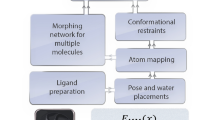Abstract
The development of computational methods that can estimate the various pharmacodynamic and pharmacokinetic parameters that characterise the interaction of drugs with biological systems has been a highly pursued objective over the last 50 years. Among all, methods based on ligand information have emerged as simple, yet highly efficient, approaches to in silico pharmacology. With the recent impact on the identification of new targets for known drugs, they are again the focus of attention in chemical biology and drug discovery.
Access this chapter
Tax calculation will be finalised at checkout
Purchases are for personal use only
Similar content being viewed by others
References
Ekins, S., Mestres, J., and Testa, B. (2008) In silico pharmacology for drug discovery: methods for virtual ligand screening and profiling. Br. J. Pharmacol. 152, 9–20.
Ekins, S., Mestres, J., and Testa, B. (2008) In silico pharmacology for drug discovery: applications to targets and beyond. Br. J. Pharmacol. 152, 21–37.
Hansch, C. and Fujita, T. (1964) Rho-sigma-pi analysis: a method for the correlation of biological activity and chemical structure. J. Am. Chem. Soc. 86, 1616–1626.
Hansch, C., Hoekman, D., Leo, A., Weininger, D., and Selassie, C. D. (2002) Chem-bioinformatics: comparative QSAR at the interface between chemistry and biology. Chem. Rev. 102, 783–812.
Kurup, A. (2003) C-QSAR: a database of 18,000 QSARs and associated biological and physical data. J. Comput. Aided Mol. Des. 17, 187–196.
Lahana, R. (1999) How many leads from HTS? Drug Discov. Today 4, 447–448.
Bajorath, J. (2002) Integration of virtual and high-throughput screening. Nat. Rev. Drug Discov. 1, 882–894.
Willett, P. (2003) Similarity-based approaches to virtual screening. Biochem. Soc. Trans. 31, 603–606.
Lengauer, T., Lemmen, C., Rarey, M., and Zimmermann, M. (2004) Novel technologies for virtual screening. Drug Discov. Today 9, 27–34.
Bleicher, K. H., Böhm, H. -J., Müller, K., and Alanine, A. I. (2003) Hit and lead generation: beyond high-throughput screening. Nat. Rev. Drug Discov. 2, 369–378.
Shoichet, B. K. (2004) Virtual screening of chemical libraries. Nature 432, 862–865.
Mestres, J. (2004) Computational chemogenomic approaches to systematic knowledge-based drug discovery. Curr. Top. Drug Discov. Dev. 7, 304–313.
Savchuk, N. P., Balakin, K. V., and Tkachenko, S. E. (2004) Exploring the chemogenomic knowledge space with annotated chemical libraries. Curr. Opin. Chem. Biol. 8, 412–417.
Bredel, M. and Jacoby, E. (2004) Chemogenomics: an emerging strategy for rapid target and drug discovery. Nat. Rev. Genetics 5, 262–275.
Bajorath, J. (2008) Computational analysis of ligand relationships within target families. Curr. Opin. Chem. Biol. 12, 352–358.
Karelson, M. (2000) Molecular descriptors in QSAR/QSPR. Wiley-VCH: New York.
Todeschini, R. and Consonni, V. (2000) Handbook of molecular descriptors. Wiley-VCH: New York.
Walters, W. P. and Goldman, B. B. (2005) Feature selection in quantitative structure-activity relationships. Curr. Opin. Drug Discov. Devel. 8, 329–333.
Willett, P. (2006) Similarity-based virtual screening using 2D fingerprints. Drug Discov. Today 11, 1046–1053.
Mestres, J., Gregori-Puigjané, E., Valverde, S., and Solé, R. V. (2009) The topology of drug-target interaction networks: implicit dependence on drug properties and protein families. Mol. Biosyst. 5, 1051–1057.
Gregori-Puigjané, E. and Mestres, J. (2006) SHED: Shannon entropy descriptors from topological feature distributions. J. Chem. Inf. Model. 46, 1615–1622.
Gregori-Puigjané, E. and Mestres, J. (2008) A ligand-based approach to mining the chemogenomic space of drugs. Comb. Chem. High Throughput Screen. 11, 669–676.
Keiser, M. J., Roth, B. L., Armbruster, B. N., Ernsberger, P., Irwin, J. J., and Shoichet, B. K. (2007) Relating protein pharmacology by ligand chemistry. Nat. Biotechnol. 25, 197–206.
Keiser, M. J., Setola, V., Irwin, J. J., Laggner, C., Abbas, A. I., Hufeisen, S. J., Jensen, N. H., Kuijer, M. B., Matos, R. C., Tran, T. B., Whaley, R., Glennon, R. A., Hert, J., Thomas, K. L. H., Edwards, D. D., Shoichet, B. K., and Roth, B. L. (2009) Predicting new molecular targets for known drugs. Nature 462, 175–182.
Campillos, M., Kuhn, M., Gavin, A. -C., Jensen, L. J., and Bork, P. (2008) Drug target identification using side-effect similarity. Science 321, 263–266.
Acknowledgments
Funding for this research was received from the Instituto de Salud Carlos III and the Spanish Ministerio de Ciencia e Innovación (project BIO2008-02329). GRIB is a node of the Instituto Nacional de Bioinformática (INB) and a member of the RETIC COMBIOMED network.
Author information
Authors and Affiliations
Editor information
Editors and Affiliations
Rights and permissions
Copyright information
© 2011 Humana Press
About this protocol
Cite this protocol
Vidal, D., Garcia-Serna, R., Mestres, J. (2011). Ligand-Based Approaches to In Silico Pharmacology. In: Bajorath, J. (eds) Chemoinformatics and Computational Chemical Biology. Methods in Molecular Biology, vol 672. Humana Press, Totowa, NJ. https://doi.org/10.1007/978-1-60761-839-3_19
Download citation
DOI: https://doi.org/10.1007/978-1-60761-839-3_19
Published:
Publisher Name: Humana Press, Totowa, NJ
Print ISBN: 978-1-60761-838-6
Online ISBN: 978-1-60761-839-3
eBook Packages: Springer Protocols




